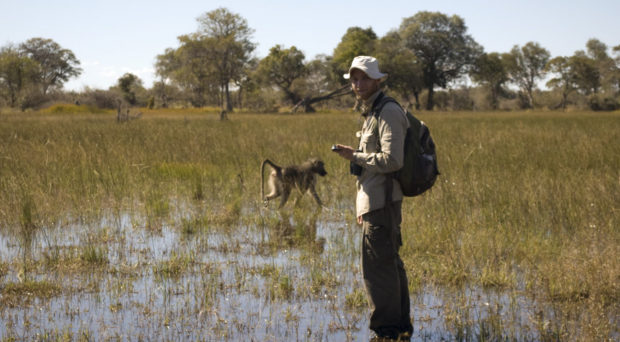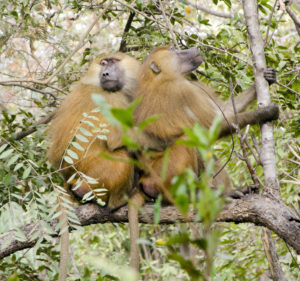
For several months of the year, the Okavango Delta in Botswana becomes a largely flooded inland delta consisting of many small islands, separated by a vast network of rivers. Each morning during my field research, Alec, our field assistant, Marc, a Master’s student from Austria and I, a Ph.D. student from Germany, took a small motorboat from our camp to one of the islands to follow our study group of chacma baboons (Papio ursinus).
We had been following this group for several weeks, but something was different on this morning. Usually the adult males tried to keep their distance from one another, but this day Asterix was closely following Gudu, a higher ranking male. Every time Asterix approached, Gudu moved away at least 20 meters. This “game” went on for hours.
We had been following this group for several weeks, but something was different on this morning.
Suddenly, Asterix jumped on Gudu and sank his long, sharp canines into Gudu’s neck. Gudu immediately countered and, for a few seconds, both males were intertwined on the ground, before the quiet but violent fight ended without an obvious winner. The two males, heavily bleeding, moved away from each other in different direction. Both of them survived. A few weeks later Asterix became alpha male.
About one year later, and 5500 km away, I followed a group of Guinea baboons (P. papio) in Senegal. The group had spent the night in the gallery forest along the Gambia River, a perfect site for baboons to find protection from leopards. In the morning, the group moved away from the river to forage in the mostly rocky and dry habitat.
I observed how two of the adult males, Peter and Ousman, approached and hugged each other before Peter “waggled” away, a strange type of movement that I had never observed in a context outside of such “greetings”. It was puzzling to me why male Guinea baboons got along so well with each other while male chacma baboons were commonly aggressive and intolerant.

Among the six baboon species, male chacma baboons presumably show the lowest tolerance and highest aggressiveness, while male Guinea baboons rarely show aggressive behaviors at all. Instead, they often show their conspicuous “greetings”, during which they sometimes even pull each other’s penis (which requires a lot of trust!). The high degree of male cooperation and tolerance in Guinea baboons has been associated with the observation that males tend to stay in their natal community, thus they have more opportunities to form long-lasting bonds with each other.
In my PhD I wanted to investigate behavioral and hormonal differences between these two “most extreme” species. My behavioral observations confirmed the interspecific differences in aggressiveness and tolerance. This finding led me to the question of whether such behavioral differences could be genetic.
Previous studies showed that levels of aggression are associated with activity of the serotonin (5-HT) neurotransmitter system. Accordingly, many researchers interested in the genetic foundation of aggression have investigated genes involved in the 5-HT metabolism. In primates (including humans), the two genetic polymorphisms 5-HTTLPR and MAOALPR (the ‘warrior gene’) were most commonly linked to aggressiveness. One of these studies suggested that both polymorphisms were linked to behavioral differences among macaque species (Macaca spp.), a genus closely related to baboons. Therefore, we decided to compare 5-HTTLPR and MAOALPR among baboons.
It was puzzling to me why male Guinea baboons got along so well with each other while male chacma baboons were commonly aggressive and intolerant.
In addition to samples from chacma and Guinea baboons, we included samples from several populations of olive (P. anubis), yellow (P. cynocephalus), and hamadryas baboons (P. hamadryas). Similar to male chacma baboons, male olive and yellow baboons aggressively compete over high rank to obtain access to receptive females. Hamadryas baboons are distinct from other baboons in their social behavior, but males show levels of aggression and tolerance more similar to Guinea baboons than to the other baboon species.
Counter to our expectations, our results did not support the involvement of 5-HTTLPR in behavioral differences among baboons. With the exception of some hamadryas baboons, all baboons carried the same 5-HTTLPR allele.
MAOALPR, on the other hand, was highly variable and the two observed populations of chacma and Guinea baboons were the most distinctly different from each other. However, some species showed as much variation within species as between species.
Even though baboons are relatively well studied, most of our knowledge comes from a few populations. For some populations, data on aggressiveness and tolerance are not comparable to other studies or have not been published at all. This makes it difficult to draw conclusions about behavioral differences on a population level. Therefore, it is currently not possible to conclude if the MAOALPR pattern is reflected in such behavioral differences.
Our results did not confirm our predictions about variation in 5-HTTLPR and MAOALPR among species. Nevertheless, I still believe that baboons represent a well suited model to investigate the causes and mechanisms of “inter-specific” differences in behavior. Future investigations, however, should try to acquire behavioral data on a population level and include a wider range of genetic data, including coding and non-coding regions of genes linked to the control of different neurotransmitter systems.
Comments